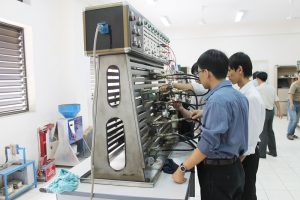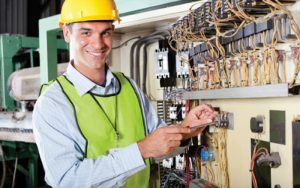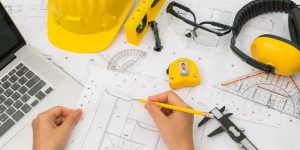1. An overview of the work of an electromechanical engineer
Electromechanical is one of the fields that everyone is interested in because it mainly serves people’s daily activities and many other business and production activities. From the installation of residential electrical systems, commercial electricity, business electricity to many other electrical devices being used every day, it all requires skillful hands and electromechanical thinking of engineers. monk. For that reason, the need for M&E engineers becomes more essential because the characteristics of this industry require expertise to be able to do it.
As can be seen, 100% of the current production workshops, not necessarily the electrical equipment factories, all need a team of electromechanical engineers. Or an apartment building, a large commercial center always has a technical room for these engineers. And of course, wherever there is human activity, electricity is needed as a “cultural universality of modernity”. Not only that, the demand for electronic recruitment is increasing, along with the salary for this position is quite stable and almost unaffected by any factors or the economic crisis. From those reasons, electrical engineering has become a profession that is pursued by a large number of people today.
2. Job responsibilities of an electromechanical engineer
2.1. Design and check drawings

For an electromechanical engineer, the first responsibility that you need to perform is to design electrical construction drawings, also known as M&E design. Electromechanical engineers will deploy the electrical system model in 3D, along with making Revit MEP and AutoCAD drawings to be able to build an electrical system from general to detailed. In general, the design task should always follow a specific process that ranges from field analysis, to reading specifications and to design making. During the design process, M&E engineers will have to continuously coordinate with the construction designer to be able to have reasonable electrical lines, both to ensure safety, convenience and to achieve aesthetics at the construction sites. this place. Of course, in the process of designing that drawing, the electrical engineer must also be accompanied by the task of checking the drawing before going through to the construction step. This is to ensure accurate specifications as well as detect errors and promptly correct them.
2.2. Deployment and supervision of M&E . construction
After having a complete drawing, the M&E engineers will proceed to a second task, which is to deploy and supervise M&E construction. Abbreviation Mechanical & Electrical means mechanical and electrical (mechanical), M&E construction has become popular in people’s lives. For this construction responsibility, M&E engineers can undertake 1 of the following 4 items:
- The first is the ventilation and air conditioning system
- The second is the water supply and drainage system and sanitary equipment
- The third is the power system
- Fourth is the fire protection system
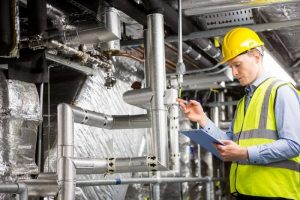
2.3. Separation of construction equipment materials
Third, indispensable in the job responsibility of the electromechanical engineer is the separation of materials and equipment. The construction and installation process always includes a combination of construction workers, machines, materials used and other construction costs. The job here of the electromechanical engineer is to keep a detailed record of those costs to account with the accountant or with the customer. Note that in this responsibility for material removal, you must calculate the exact factors: quantity, unit price, tax price for each specific item or equipment. Then calculate the total and send it back to the department responsible for payment. This is considered an important step in calculating the value of the project that electrical engineers are in charge of. So in order to do this job well, M&E engineers also need to combine with other departments to have the most accurate and complete material dissection.
2.4. Track operation and usage
After completing all construction and accounting works, the responsibility of the electromechanical engineer still does not stop. You will continue to take on the next task of monitoring the operation and use of that electromechanical system. Usually this monitoring will take place for at least 1 month to 1 year after installation. Electromechanical engineers will have to ensure the continuous, safe and economical operation of these systems. At the same time, the electromechanical engineer also detects errors, leaks and corrects the arising of complications that are beyond your original design and prediction. This is considered a fairly important maintenance task for the mechanical and electronic field today, especially in large-scale projects with complex M&E systems.
Not only proactively detecting and repairing, customers can also be the first to discover and report problems to your corporation. Therefore, at this time, the electromechanical engineer will also be the one to visit the field as well as solve those questions and requirements by checking and fixing them. Ensure customer satisfaction and maintenance limits in the company’s regulations.
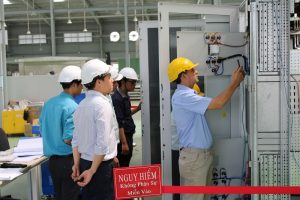
2.5. Report jobs
And finally, in the job description, an electrical engineer is always responsible for the job report. Here, electromechanical engineers will have to report to 2 positions, the first is the technical manager and the second is to the management board. In which, reporting to the technical manager includes:
Work progress report
Report on the volume of materials and equipment of the project
Asking for comments and problems arising and proposing during the construction process
This report will take place in accordance with a general time regulation, this is aimed at helping the technical department heads to keep a close eye on the situation and closely manage the construction process of the electromechanical engineers.
In addition, the M&E engineer is also responsible for reporting to the company’s management when required, usually only when there is an unexpected problem. However, before that, the M&E engineers have to go through the head of the technical department to submit the reports to the management.
